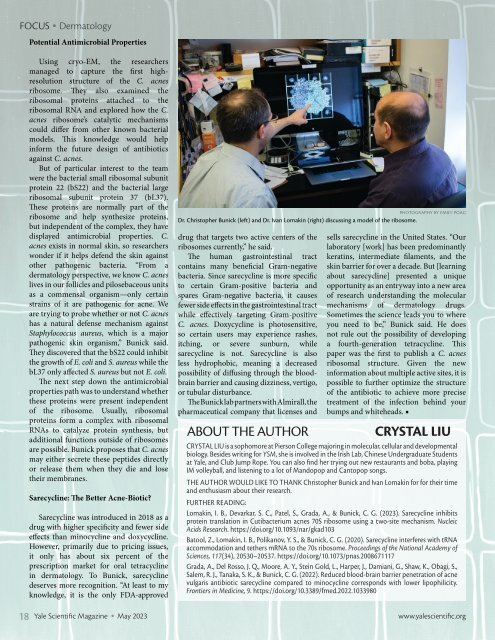YSM Issue 96.2
Create successful ePaper yourself
Turn your PDF publications into a flip-book with our unique Google optimized e-Paper software.
FOCUS<br />
Dermatology<br />
Potential Antimicrobial Properties<br />
Using cryo-EM, the researchers<br />
managed to capture the first highresolution<br />
structure of the C. acnes<br />
ribosome. They also examined the<br />
ribosomal proteins attached to the<br />
ribosomal RNA and explored how the C.<br />
acnes ribosome’s catalytic mechanisms<br />
could differ from other known bacterial<br />
models. This knowledge would help<br />
inform the future design of antibiotics<br />
against C. acnes.<br />
But of particular interest to the team<br />
were the bacterial small ribosomal subunit<br />
protein 22 (bS22) and the bacterial large<br />
ribosomal subunit protein 37 (bL37).<br />
These proteins are normally part of the<br />
ribosome and help synthesize proteins,<br />
but independent of the complex, they have<br />
displayed antimicrobial properties. C.<br />
acnes exists in normal skin, so researchers<br />
wonder if it helps defend the skin against<br />
other pathogenic bacteria. “From a<br />
dermatology perspective, we know C. acnes<br />
lives in our follicles and pilosebaceous units<br />
as a commensal organism—only certain<br />
strains of it are pathogenic for acne. We<br />
are trying to probe whether or not C. acnes<br />
has a natural defense mechanism against<br />
Staphylococcus aureus, which is a major<br />
pathogenic skin organism,” Bunick said.<br />
They discovered that the bS22 could inhibit<br />
the growth of E. coli and S. aureus while the<br />
bL37 only affected S. aureus but not E. coli.<br />
The next step down the antimicrobial<br />
properties path was to understand whether<br />
these proteins were present independent<br />
of the ribosome. Usually, ribosomal<br />
proteins form a complex with ribosomal<br />
RNAs to catalyze protein synthesis, but<br />
additional functions outside of ribosomes<br />
are possible. Bunick proposes that C. acnes<br />
may either secrete these peptides directly<br />
or release them when they die and lose<br />
their membranes.<br />
Sarecycline: The Better Acne-Biotic?<br />
Sarecycline was introduced in 2018 as a<br />
drug with higher specificity and fewer side<br />
effects than minocycline and doxycycline.<br />
However, primarily due to pricing issues,<br />
it only has about six percent of the<br />
prescription market for oral tetracycline<br />
in dermatology. To Bunick, sarecycline<br />
deserves more recognition. “At least to my<br />
knowledge, it is the only FDA-approved<br />
PHOTOGRAPHY BY EMILY POAG<br />
Dr. Christopher Bunick (left) and Dr. Ivan Lomakin (right) discussing a model of the ribosome.<br />
drug that targets two active centers of the<br />
ribosomes currently,” he said.<br />
The human gastrointestinal tract<br />
contains many beneficial Gram-negative<br />
bacteria. Since sarecycline is more specific<br />
to certain Gram-positive bacteria and<br />
spares Gram-negative bacteria, it causes<br />
fewer side effects in the gastrointestinal tract<br />
while effectively targeting Gram-positive<br />
C. acnes. Doxycycline is photosensitive,<br />
so certain users may experience rashes,<br />
itching, or severe sunburn, while<br />
sarecycline is not. Sarecycline is also<br />
less hydrophobic, meaning a decreased<br />
possibility of diffusing through the bloodbrain<br />
barrier and causing dizziness, vertigo,<br />
or tubular disturbance.<br />
The Bunick lab partners with Almirall, the<br />
pharmaceutical company that licenses and<br />
ABOUT THE AUTHOR<br />
sells sarecycline in the United States. “Our<br />
laboratory [work] has been predominantly<br />
keratins, intermediate filaments, and the<br />
skin barrier for over a decade. But [learning<br />
about sarecycline] presented a unique<br />
opportunity as an entryway into a new area<br />
of research understanding the molecular<br />
mechanisms of dermatology drugs.<br />
Sometimes the science leads you to where<br />
you need to be,” Bunick said. He does<br />
not rule out the possibility of developing<br />
a fourth-generation tetracycline. This<br />
paper was the first to publish a C. acnes<br />
ribosomal structure. Given the new<br />
information about multiple active sites, it is<br />
possible to further optimize the structure<br />
of the antibiotic to achieve more precise<br />
treatment of the infection behind your<br />
bumps and whiteheads. ■<br />
CRYSTAL LIU<br />
CRYSTAL LIU is a sophomore at Pierson College majoring in molecular, cellular and developmental<br />
biology. Besides writing for <strong>YSM</strong>, she is involved in the Irish Lab, Chinese Undergraduate Students<br />
at Yale, and Club Jump Rope. You can also find her trying out new restaurants and boba, playing<br />
IM volleyball, and listening to a lot of Mandopop and Cantopop songs.<br />
THE AUTHOR WOULD LIKE TO THANK Christopher Bunick and Ivan Lomakin for for their time<br />
and enthusiasm about their research.<br />
FURTHER READING:<br />
Lomakin, I. B., Devarkar, S. C., Patel, S., Grada, A., & Bunick, C. G. (2023). Sarecycline inhibits<br />
protein translation in Cutibacterium acnes 70S ribosome using a two-site mechanism. Nucleic<br />
Acids Research. https://doi.org/10.1093/nar/gkad103<br />
Batool, Z., Lomakin, I. B., Polikanov, Y. S., & Bunick, C. G. (2020). Sarecycline interferes with tRNA<br />
accommodation and tethers mRNA to the 70s ribosome. Proceedings of the National Academy of<br />
Sciences, 117(34), 20530–20537. https://doi.org/10.1073/pnas.2008671117<br />
Grada, A., Del Rosso, J. Q., Moore, A. Y., Stein Gold, L., Harper, J., Damiani, G., Shaw, K., Obagi, S.,<br />
Salem, R. J., Tanaka, S. K., & Bunick, C. G. (2022). Reduced blood-brain barrier penetration of acne<br />
vulgaris antibiotic sarecycline compared to minocycline corresponds with lower lipophilicity.<br />
Frontiers in Medicine, 9. https://doi.org/10.3389/fmed.2022.1033980<br />
18 Yale Scientific Magazine May 2023 www.yalescientific.org

















